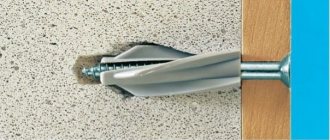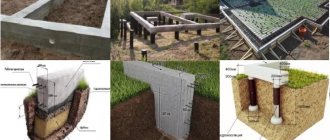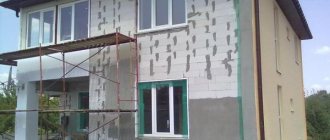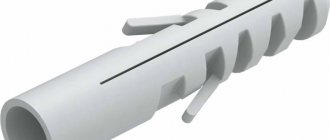Aerated concrete is often used in the construction of houses and other premises, so it is important to understand the technology for fastening dowels into aerated concrete. Due to the porous texture of aerated concrete, you need to carefully consider the fastening connection. On sale you can find special fasteners for aerated concrete. Please note that not all dowels can be attached to porous material. In this article, we will look at the features of dowels, the specifics of their fastening, and the key rules that should be followed when working with products.
Aerated concrete - what kind of material is it?
This is an affordable material suitable for the construction of houses and buildings. The main difference between aerated concrete is its porous structure, which is why it is considered fragile and easy to work with. You can easily cut the material to the desired configuration, trim it or trim it according to a template. Conventional dowels cannot be used because they cannot guarantee secure fastening.
In this case, only special dowels for aerated concrete are suitable. They differ from traditional ones in design. The bushing has a spiral shape with a grooved surface. The ribs located on the outside expand when screwed in. They easily fit into the loose structure, ensuring a reliable connection. This design can withstand heavy loads. Using dowels, you can attach cabinets, shelves, and decorative items to walls.
Tool and surface features
Installation tools:
- electric hand drill;
- drill bit with pobedite tip;
- hammer;
- a wrench or screwdriver for screwing in a screw;
- adhesive mixture for chemical anchor;
- special gun for glue mixture.
The main condition when installing objects and accessories is the correct choice of hardware.
Aerated concrete, having a porous structure, is a relatively fragile material, so the question arises - what kind of hardware is needed to ensure that the fastening is reliable and meets all the operating requirements of the structure.
There is a wide range of products that make it possible to fasten structures reliably and quickly.
From the video below you will learn about fasteners for aerated concrete.
What types of dowels are there?
All dowels differ in the shape of the ribs for fixation and the installation method. Dowels can be driven or screwed into the base. Screwing dowels into aerated concrete is considered the most reliable method. Let's look at the main types of fasteners that can be found on sale:
- Metal. For their production, galvanized steel is mainly used. The fasteners are highly fire resistant, can withstand heavy loads and are used for installing various pipelines. Metal dowels have a special collar that prevents rotation. The main disadvantage of metal dowels is the risk of corrosion. For aerated concrete, a metal dowel is suitable.
- Plastic. Made from durable materials that will not rust over the years. Mostly plastic products have ribs in the form of spirals. They provide a reliable connection to porous materials. Plastic dowels are environmentally friendly and can guarantee a strong fastening. Plastic is not exposed to aggressive factors, so dowels are quite common. The cost of plastic fasteners is an order of magnitude cheaper than their metal counterparts. Experts do not recommend plastic dowels for outdoor use due to their instability to temperature changes.
- Nylon. Such dowels, as well as plastic versions, are not subject to corrosion. The advantage of choosing nylon will be its strength and durability. Due to the relatively high cost, the demand for them is not so great. Most often, nylon dowels are used when installing doors, windows, and mirrors.
- Chemical. A special dowel for aerated concrete, which is used for installing large and heavy objects. Chemical anchors come to the rescue in cases where standard metal fasteners cannot cope with the task. When installing a chemical anchor, it is installed in the pilot hole with a special adhesive applied for more reliable fixation.
- Universal. Suitable for all types of surfaces, including porous aerated concrete. The design includes a spacer part. When immersing hardware, the universal dowel fixes it according to the principle of a standard expansion-type dowel.
- Gvozdeva. It is also called a dowel-nail. The structure provides for two struts without a toothed covering. When installing a nail dowel, you need to install a sleeve. It will prevent the hardware from scrolling. Anchor nails are budget fasteners designed for objects of insignificant weight. The main advantage is considered to be simple installation.
- Frame. There are models made of plastic and metal. Frame dowels are great for loose surfaces because they correctly distribute the load, which is mostly placed on the fastener itself.
- Thermal insulation. Most often used for fixing insulation. Suitable for working with concrete, brick and softer surfaces.
Shear test results
In the first part of the tests, we loaded the fastener with shear force (a transverse force acting perpendicular to the axis of the fastener). To do this, we used a chain hoist, crane scales and a handmade adapter that we made specifically for this test.
1. First dowel tested - SORMAT KBT 6
Finnish production, in everyday life “piggy” or “pig tail”. The outer diameter for the drill is 10 mm. The hole was drilled in a non-impact mode, as for all subsequent fasteners, so as not to crumble the aerated concrete. A six-millimeter screw was screwed inside.
The manufacturer states that its permissible load in the five hundredth concrete is 400 N, which corresponds to 40 kg. Taking into account the safety factor 3 specified by the manufacturer, we obtain a calculated breaking load of 120 kg.
- Test results: 203 / 208 / 165.5 kg.
- The average breaking load was 192 kg.
Considering that in real projects the masonry mortar prevents the block from splitting, the holding force of SORMAT KBT 6 is quite high and stable.
2. The first candidate in metal version SORMAT KBTM 6
, cast from an alloy of zinc and aluminum (Zn Al4 Cu1). Installation in a pre-drilled hole with a diameter of 10 mm and a depth of 60 mm.
In fact, there shouldn’t be a significant difference in load-bearing capacity, so why pay more? Perhaps for fire safety purposes, since a polyamide dowel can only be used at temperatures from -40 to +80°C, while a metal dowel will withstand open fire. In combination with metal KBTM 6, fasteners with metric threads, such as screws, bolts, including hooks, are used. In addition, the metal version allows this dowel to be used in expanded clay concrete.
- Test results: 270 / 250 / 256 kg.
- The average maximum load is 258 kg.
An unexpected result - plus 60 kg! The metal dowel outperformed its plastic counterpart. It seemed to us that at the moment the metal dowel comes out of the hole, its side, together with the bolt, creates a horizontal stop along the entire depth of the fastener, while a greater bend occurs on the nylon analogue, which destroys the aerated concrete at the exit from the hole.
3. The third number is GB 10
made of polyamide from the German brand FISCHER. We drilled a hole under it with a diameter of 10 mm, a length of at least 65 mm and used a universal 6 mm screw. According to the manufacturer, the recommended load in GB4.4 aerated concrete is 540 N or 54 kg. Having tested the ultimate resistance to destruction in practice, we obtained:
- Test results: 296 / 326 / 344 kg.
- The average breaking load was 322 kg.
The result inspires respect, the nylon dowel GB 10 FISCHER has proven itself to be a stable and reliable fastening in aerated concrete, capable of bearing the weight of quite heavy objects.
4. The fourth fastener for aerated concrete is the PB 10 dowel
, an analogue of FISCHER GB made in China, made of cheap plastic. It is 5 mm longer than the original, otherwise the shape is identical.
- Test results: 254 / 217 / 307 kg.
- The average breaking load was 260 kg.
What do we see? The Chinese-made plastic dowel showed an average breaking load of 260 kg, which is only 20% less than that of the nylon branded FISCHER GB.
5. Fifth in line for testing - metal dowel for aerated concrete 8x60 mm
, called because of its jagged shape - “herringbone” or “crocodile”. Cheap, therefore very popular fasteners for aerated concrete. We use it with a 6 mm screw, although it is also suitable for working with a wood grouse screw. We drill a hole with a diameter of 10 mm for it.
- Test results: 236 / 215 / 357 kg.
- The average breaking load was 237 kg.
Conclusion: the 8x60 mm toothed metal dowel showed a significant shear result, although not the highest. It can be safely used for wall mounting of fairly weighty structures, and where, for fire safety reasons, plastic fasteners cannot be installed.
6. The next test sample is the red triangular dowel TOX GB (Ytox)
made of nylon. It has the shape of a triangular wedge with a spacer zone along almost the entire length. For testing, we chose the smaller of the presented standard sizes – 10x55 mm. Its installation is similar to FISCHER GB.
- Test results: 270 / 276 / 294 kg.
- Average breaking load: 280 kg.
Although the maximum load of TOX is 13% lower than that of FISCHER GB, it is also stable. This is a rather rare brand in Russia. Among the few reviews about this dowel, there are positive and negative. Dissatisfied customers prefer FISCHER GB. See “TOX GB Reviews on AMAZON”.
FISCHER FPX M8 passed the test under number seven
– drive-in anchor for aerated concrete with internal metric thread and four spacer plates. The maximum load-bearing capacity in GB 500 kg/mm², declared by the manufacturer, is 0.62 kN or 62 kg. We drilled a hole with a 10 mm drill, hammered an anchor into it and wedged the wings, rotating the hexagon clockwise. After this, the bolt was screwed in, thereby securing the part to the base.
- Test results: 391 / 405 / 512 kg.
- Average shear load: 436 kg.
Amazingly high pullout resistance - 436 kg average, with a peak value of 512 kg! And if you consider that the maximum permissible load is 62 kg, then the safety factor is 7. This is one of the most reliable fastenings in aerated concrete among those already tested. It’s not for nothing that in the video for this dowel we gave it the prefix “TOP” in advance, it’s a bomb!
8. TOX APOLLO VLF
is a unique dowel with a metal tip, developed by German engineers. External diameter – 8 mm, length – 100 mm. The screw is included. In porous concrete, it cuts and forms a knot, due to which it is fixed. And how firmly it is held, let’s look at the values obtained during testing:
- Results of 3 tests: 298 / 372 / 339 kg.
- Average breaking load: 336 kg.
Based on the test results, we see that the APOLLO VLF dowel, despite its outer diameter of 8 mm, shows a high shear load. It’s worth clarifying here: why did the first test show a lower result? Perhaps due to the fact that it was not immediately clear to us at what point to stop when twisting. The second time you do it more confidently. High retention values were achieved after 6 revolutions.
9. Last on the list for testing is a self-tapping screw for aerated concrete 8x100 mm DOMAX (DMX)
, allowing for quick installation without pre-drilling and laying dowels.
- Results of 3 tests: 58 / 54.5 / 69.5 kg.
- Average breaking load: 61 kg.
This fastener showed the lowest holding capacity. The peak load at which failure begins is on average only 61 kg. This is the weakest fastener for aerated concrete, capable of holding only very light objects such as wall clocks and photo frames.
Which dowel for aerated concrete is better?
To choose the most suitable dowel from the options described above, pay attention to the following recommendations from experts:
- to fix mirrors, lamps and similar items, use nylon dowels;
- for outdoor work, choose metal fasteners;
- when installing large and heavy objects, metal dowels are better suited;
- for reliable facade connections - special fasteners made of durable plastic;
- when installing windows or doors, frame dowels will be a priority;
- to fix decorative objects, you can limit yourself to a regular nail without a dowel.
Features of choice
When figuring out which dowel option to choose, you should be guided by the specific situation. For mounting a lamp or hanging mirror, it is more practical to use nylon fasteners. If you need to hang pipes, metal products are suitable. If you want to fix heavy furniture to the wall, it is better to purchase special metal fasteners. If you want to improve the façade surface, it is better to choose plastic parts designed specifically for this purpose. Frame fasteners are indispensable when installing window or door blocks in openings.
Installing dowels in aerated concrete: step-by-step guide
The principle of installing dowels in aerated concrete is practically no different from other surfaces. Focus on the following rules:
- It is important to make a pilot hole that matches the diameter of the dowel. It is important that the hole is smaller than the fastener. For example, for 10 mm fasteners you need to prepare a hole with a diameter of 9 mm.
- When working with a hammer drill, avoid impact mode. A drill is considered a more suitable tool.
- A screwdriver is suitable for screwing in the plastic dowel. With metal dowels, use a hammer.
- After installing the cuff all the way, proceed to screwing in the self-tapping screw.
Fastening building structures to aerated concrete
On such fragile walls it is necessary to fix not only wires and pipes, but also heavy structures: floors, roofing elements, etc. In such cases, fixing self-tapping screws into aerated concrete is not a solution; a serious decision is needed.
As a rule, it is carried out during the process of laying walls, when a monolithic reinforced concrete armored belt is made at the installation level of such structures. During pouring, studs and other embedded parts are installed into it, onto which the fastening is subsequently carried out.
If for some reason you did not make an armored belt, or did not provide mortgages in it, fastening is carried out only with chemical anchors.Why are adhesives applied when installing dowels?
Adhesive mixtures are special compounds that are used to ensure the reliability of complex joints. Most of them contain epoxy resin, which has many properties. The scope of use of adhesive compositions includes fixing concrete elements and creating connections in complex technical structures.
The popularity of using special tools when working with dowels is due to the following factors:
- possibility of fastening in an aggressive environment, under the influence of moisture;
- intended for external fastenings without the risk of deformation and loosening of connections;
- eliminating stress in the dowel itself.
If you are faced with a complex design and think that an adhesive composition is needed to fix an object on an aerated concrete base, choose an option that is suitable for the price.
Typical mistakes, fastening methods, recommendations when working with dowels
If you need to install a dowel in a loose aerated concrete surface, you should not use a screwdriver. If your tool has a speed control feature, that's good. Correctly calculate the diameter of the hole itself from the rule described above: the dowel must be larger than the hole. Otherwise, reliable fixation cannot be guaranteed.
The depth of the hole should be slightly larger than the dowel itself. Please note that dowels should only be used for their intended purpose. Despite their versatility and ease of installation, experts do not recommend using such products when installing large and heavy objects. Dowels are most suitable for solving small household tasks - attaching pictures, hooks and other objects.
It is allowed to use dowels for heavier weights, but subject to mandatory compliance with all rules. The information obtained will allow you to correctly determine the type of suitable fastener and avoid common mistakes.











